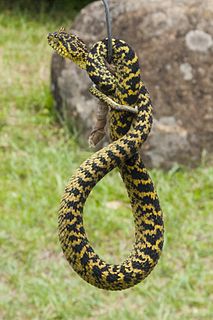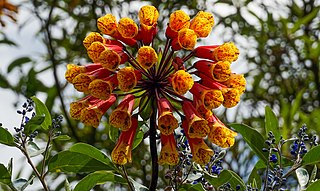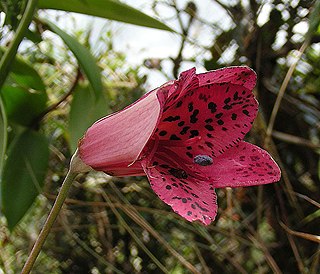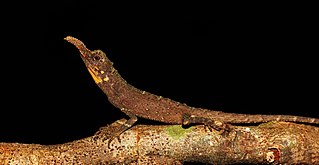
Atheris ceratophora is a venomous viper species endemic to a few mountain ranges in Tanzania. This used to be the only horned, arboreal viper known from Africa, until the discovery in 2011 of Atheris matildae, also found in Tanzania. No subspecies are currently recognized.

The golden-bellied starfrontlet is a species of hummingbird. The scientific name commemorates Charles Lucien Bonaparte.

The black inca is a species of hummingbird found only in Colombia. Its natural habitats are subtropical or tropical moist lowland forest, subtropical or tropical moist montane forest and urban areas. It is threatened by habitat loss.

Ceratophora tennentii, commonly known as the rhinoceros agama, horn-nosed lizard, and Tennent's leaf-nosed lizard, is a species of lizard in the family Agamidae. The species is endemic to Sri Lanka.
Bomarea angustifolia is a species of flowering plant in the family Alstroemeriaceae. It is endemic to Ecuador, where it is known from a single collection made during the first half of the 19th century. It is not clear exactly where the specimen was collected, but it may have been near Loja.
Bomarea borjae is a species of flowering plant in the family Alstroemeriaceae. It is endemic to Ecuador. It is known only from two collections made in the caldera of the dormant volcano Pululagua over 100 years ago. It is not a well-known species and is threatened by habitat loss.
Bomarea brachysepala is a species of flowering plant in the family Alstroemeriaceae. It is native to Peru and Ecuador. It grows in mountain forest habitat in the Andes. It is threatened by destruction of habitat caused by deforestation and mining.
Bomarea chimborazensis is a species of flowering plant in the family Alstroemeriaceae. It is endemic to Ecuador. It is a plant of páramo habitat. It is threatened by fires set by people.
Bomarea elegans is a species of flowering plants in the family Alstroemeriaceae. It is endemic to Ecuador, where it occurs in the forests and páramo of the Andes. It is threatened by fire, grazing, and mining.

Bomarea glaucescens is a species of flowering plant in the family Alstroemeriaceae. It is native to Peru, Bolivia and Ecuador. It grows in wet páramo habitat among Polylepis and next to lakes, as well as grassy páramo and Andean forests. It is not a threatened species but some populations are vulnerable to habitat destruction as the páramo is converted to pasture and pine and eucalyptus plantations.
Bomarea goniocaulon is a species of flowering plant in the family Alstroemeriaceae. It is native to Peru and to Ecuador, where it has been collected only three times in the Pichincha Province. It is known from mountain forest habitat.
Bomarea gracilis is a species of flowering plant in the family Alstroemeriaceae. It is endemic to Ecuador. It grows in forest and páramo in the Andes.
Bomarea graminifolia is a species of flowering plant in the family Alstroemeriaceae. It is endemic to Ecuador, where it has only been collected once, before 1908. The specimen probably came from the forests on the volcano Atacazo, near Quito.
Bomarea hartwegii is a species of flowering plant in the family Alstroemeriaceae. It is native to Peru and to Ecuador, where it has only been collected twice, in the Pichincha Province. It is threatened by habitat destruction.
Bomarea lanata is a species of plant in the Alstroemeriaceae family. It is endemic to Ecuador. Its natural habitat is subtropical or tropical moist montane forests. It is threatened by habitat loss.

Bomarea longipes is a species of plant in the Alstroemeriaceae family. It is endemic to Peru and Ecuador. Its natural habitat is subtropical or tropical moist montane forests. It is threatened by habitat loss.
Bomarea lutea is a species of plant in the Alstroemeriaceae family. It is endemic to Ecuador. Its natural habitat is subtropical or tropical moist montane forests. It is threatened by habitat loss.

Bomarea uncifolia is a species of plant in the family Alstroemeriaceae. It is endemic to Ecuador. Its natural habitat is subtropical or tropical moist montane forests. It is threatened by habitat loss.

The rough-nosed horned lizard or Sri Lanka horned agama is an Agamid lizard from Sri Lanka in lowland dipterocarp forests and secondary forests in the wet zone. It is distinguished from all the other Ceratophora species by the presence of a complex rostral appendage, comprising more scales than rostral scale alone. The lateral body scales are small and more or less regular shape.
Anoura peruana is a species of bat from Colombia and Peru. It was elevated to a species in 2010, after previously being considered a subspecies of Geoffroy's tailless bat. The females are larger than the males.








